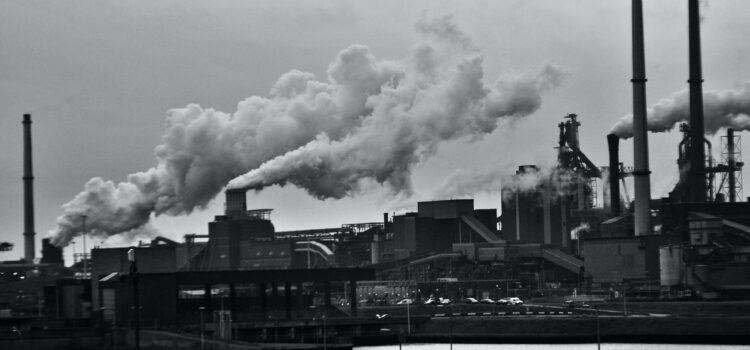

This article is an excerpt from the Shortform book guide to "How the World Really Works" by Vaclav Smil. Shortform has the world's best summaries and analyses of books you should be reading.
Like this article? Sign up for a free trial here.
What role do fossil fuels play in manufacturing? How much do renewables help? What’s the solution to carbon emissions?
Vaclav Smil believes that, in manufacturing industries, fossil fuels are here to stay—at least for the foreseeable future. Even green electricity relies on manufactured materials that are produced with power from fossil fuels. But, he says there are a few things we can do to reduce the use of these materials.
Read more to learn about why CO2 emissions from manufacturing industries are a reality we have to live with, at least for now.
CO2 Emissions From Manufacturing Industries
Smil explains that four materials—concrete, steel, plastics, and ammonia—are used more than any others in modern society. Producing these on a mass scale requires huge amounts of fossil fuels to heat their raw materials at high temperatures. Smil claims that, aside from experimental methods, there’s currently no way to manufacture these materials without the use of fossil fuels. However, he offers ideas on how we might reduce CO2 emissions from manufacturing industries.
Concrete and Steel
Concrete is made by heating limestone, clay, and shale in large kilns, then grinding the result into a cement powder. Concrete can withstand great pressure but not great tension. The discovery of how to reinforce concrete using steel bars solved that problem and led to reinforced concrete being used in every large building and transportation infrastructure worldwide. Reinforced concrete is used in skyscrapers, tunnels, sidewalks, runways, freeways, and dams, among other things.
Smil explains that one problem with concrete is that environmental factors such as moisture, freezing, and vibration can cause it to deteriorate. Its typical lifespan is between 20 and 100 years, depending on maintenance. Because much of the concrete in the world was installed in the second half of the twentieth century, it already needs to be replaced or destroyed—a project that will continue for decades to come.
(Shortform note: While Smil contends that there is no way to manufacture zero-carbon concrete, he doesn’t discuss the many manufacturers who are already making low-carbon concrete. These forms of concrete significantly reduce carbon emissions—some by up to two-thirds—by replacing some of the limestone used in the manufacturing process with clay or fly ash, or by capturing the carbon emissions from the manufacturing process and injecting them back into the concrete to strengthen it.)
Steel is used in bridges, foundations, ships, tools, machinery, pipelines, and weapons. It’s made using iron ore, which Smil points out is plentiful in the earth’s crust and not in danger of running out for generations. The ore is smelted in blast furnaces, then treated in oxygen furnaces. Producing steel is a very energy-intensive process.
Steel can be recycled by melting it in a massive furnace, but this is also energy-intensive: It requires the same amount of electricity per day as a city of 150,000 people. Still, wealthy countries do recycle most of their steel.
Steel and cement together are responsible for about 16% of carbon emissions.
(Shortform note: As with concrete, there are methods of manufacturing steel that result in fewer carbon emissions. These include using carbon capture technologies, improving the recyclability of steel, and heating iron ore with natural gas and hydrogen. Currently, seven out of 10 of the world’s biggest steel-producing countries have begun at least one such “green steel” project. Although it will be some time before green steel is adopted globally, experts say that governments can speed this transition by implementing policies that create markets for green steel, as well as by investing in the development and deployment of existing technologies.)
Plastics
Most plastics are made by heating petroleum, a refined fossil fuel, at very high temperatures. Smil says that because of their low weight and high strength, plastics are ubiquitous in modern life. They’re used in cars, planes, building materials, electronics, healthcare products, clothing, and much more.
(Shortform note: Concern over the environmental impact of plastic often focuses on plastic waste; Smil highlights the fact that fossil fuel extraction and plastic manufacturing actually produce the vast majority of plastic-related carbon emissions. Studies demonstrate that 91% of emissions from plastic come from the early stages of its life cycle, whereas only 9% are due to plastic disposal. However, plastic can be made from plant-based materials such as sugarcane and produced using renewable energy. Unlike the demand for concrete and steel, which is fueled by ever-increasing development, the demand for plastics can be reduced. For example, consumers could demand reusable glass and plant-based packaging for food and home goods.)
Ammonia
Smil says that ammonia is the most important material we use. While ammonia is used in explosives, dyes, fibers, and cleansers, 80% of it is used in agriculture. Smil explains that ammonia is the world’s primary source of nitrogen fertilizer and without it, nearly half of the world’s population would go unfed.
Ammonia is an inorganic compound composed of nitrogen and hydrogen. It can be found naturally in animal waste (manure) or it can be synthesized. The rapidly growing population in the early 20th century demanded a solution to the challenge of synthesizing ammonia to produce enough food for everyone. The problem, Smil explains, is that the synthesis of ammonia from its elements requires a huge amount of energy, and thus, the use of fossil fuels.
Today, wealthy countries use the vast majority of ammonia fertilizers and most of these are synthetic. In China, for example, 60% of the nitrogen used in agriculture comes from synthetic ammonia. Because of our life-or-death reliance on this material, Smil says, it’s one of the most difficult areas in which to reduce our use of fossil fuels.
(Shortform note: Although this doesn’t address the use of fossil fuels in synthesizing ammonia (and the resulting carbon dioxide emissions), many cost-effective, low-tech methods for reducing ammonia emissions do exist. For example, simply covering manure during storage or layering soil on top of it immediately after application on crops can significantly reduce emissions. In addition, there are many technologies that reduce agricultural greenhouse gas emissions. New Zealand is one example of a country that has significantly reduced agricultural emissions by supporting innovation and technology transfer. From 1990 to 2015, New Zealand reduced its agricultural emissions by 34%, despite the fact that agriculture makes up a significant portion of its economy.)
Cutting Down on CO2 Emissions From Manufacturing Industries
Smil says it’s unlikely that the ammonia, plastics, concrete, and steel industries will stop relying on fossil fuels anytime soon. And developing countries will need to increase their production of these materials many times over to catch up with wealthier countries. What’s more, “green” electricity, such as that generated by wind turbines and electric car batteries, relies on all of these materials and many others as well.
Nonetheless, Smil says there may be some steps we can take to cut down on the use of these materials. For example, we could use less ammonia by relying on some of the same methods as with food production: increasing food prices or eating less meat. Alternatively, we could get wealthy countries to produce less food.
(Shortform note: While Smil contends that the only way to reduce carbon emissions from these materials is to use fewer of them, many manufacturers are already implementing methods to cut down on emissions without reducing their use of these materials, as discussed in the commentary above. One such method is to create new manufacturing processes that reduce raw materials or decrease machine use. For example, one steel manufacturer removed rollers and streamlined its production process, allowing it to use smaller facilities and consume less energy and heat. This resulted in an 80-90% reduction in carbon emissions. And many building projects reduce emissions by using recycled, reclaimed, or carbon-storing materials, such as wood or hemp.)

———End of Preview———
Like what you just read? Read the rest of the world's best book summary and analysis of Vaclav Smil's "How the World Really Works" at Shortform.
Here's what you'll find in our full How the World Really Works summary:
- How modern-day life relies heavily on fossil fuels for nearly everything
- Why liberals and conservatives need to better understand how the world works
- Why it's nearly impossible to meet current IPCC limits on global warming






